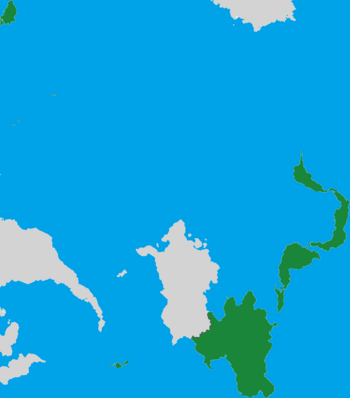Hoshiokan Empire
Jump to navigation
Jump to search
Greater Hoshiokan Empire 大星を超帝國 | |
|---|---|
|
Flag | |
Motto: 天皇陛下万歳! Long Live the Emperor! | |
 Hoshioko within East Ourika | |
| Status | Extant |
| Capital | Daikyo |
| Largest | Okuoka |
| Official languages | Hoshiokan |
| Recognised regional languages | Hoshiran |
| Ethnic groups (2019) | Hoshiokan __% Hoshiran __% Other __% |
| Religion (2019) | Traditional Folk: _% Nonreligious: __% Other: __% [not!Christianity]: __% |
| Demonym(s) | Hoshiokan |
| Government | Constitutional Monarchy |
• Emperor | Kagahito |
• Chancellor | TBD |
• Speaker for the Peers | TBD |
• Lord Justice | TBD |
• Chief of Staff, Imperial General Headquarters | TBD |
| Legislature | Imperial Diet |
| Chamber of Peers | |
| Chamber of Representatives | |
| Sovereign Territory | |
• Mythological foundation | [TBD] |
• Drafting of Restoration Constitution | [TBD] |
| Area | |
• Total | 1,296,405 km2 (500,545 sq mi) |
• Density | 154.45/km2 (400.0/sq mi) |
| GDP (PPP) | 2019 estimate |
• Total | RZ$ 4.9 trillion ([TBD]) |
• Per capita | RZ$ 24,457 ([TBD]) |
| Gini | 37.7 medium · [TBD] |
| HDI (2019) | .824 very high · [TBD] |
| Currency | Hoshiokan Koban (交) (HSK) |
| Time zone | UTC[TBD] ([TBD]) |
• Summer (DST) | UTC[TBD] ([TBD]) |
| Date format | dd-mm-yyyy, CE dd-mm-Regnal Year |
| Driving side | left |
| Calling code | +23 |
| Internet TLD | .hs |
The Greater Hoshiokan Empire is a thassalocratic state in eastern Ourika.
History
Pre-History
Classical
Warring States
Unification & Centralisation
Hanko Era
Chouwa Era
Geography
Home Islands
Shitsujima
Anterior Territories
Politics
Government
Administrative Divisions
The Hoshiokan Empire consists of sixty-three prefectures in seven regions: Yosaika, Kanminami, Kyoete, Yamasugi, Natsukuni, Shitsujima, and Maeryodo.
Foreign Affairs
Defense
Military
Main Article: Imperial Hoshiokan Army; Imperial Hoshiokan Navy
Law Enforcement
Main Article: Imperial Hoshiokan Gendarmerie, Imperial Special Police


